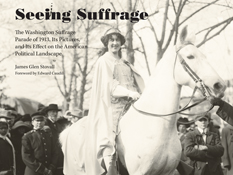Seeing Suffrage
The 1913 Washington Suffrage Parade, Its Pictures, and Its Effects on the American Political Landscape

On March 3, 1913, the day before Woodrow Wilson’s inauguration, leaders of the American suffrage movement organized an enormous march through the capital that served as an important salvo on the long road to the passage of the Nineteenth Amendment. Coinciding with the widespread rise of photography in daily newspapers and significant shifts in journalism, the parade energized a movement that had been in the doldrums for nearly two decades. In Seeing Suffrage, James G. Stovall combines a detailed account of the parade with more than 130 photographs to provide a stunning visual chronicle of one of the most pivotal moments in the struggle for women’s rights.
Although the women’s suffrage movement was sixty-five years old by 1913, the belief that women should vote was still controversial. Reactions to the march—a dazzling spectacle involving between five thousand and eight thousand participants—ranged from bemusement to resistance to violence. The lack of cooperation from the Washington police force exacerbated conflicts along the route and, ultimately, approximately one hundred marchers and participants were injured. Although suffrage leaders publicly expressed disgust at the conduct of the crowd and police, privately they were delighted with the turn of events, taking full advantage of the increased media coverage by repeatedly tying the unruly mob and the actions of the police to those who opposed votes for women.
The 1913 procession stands as one of the first political events in American history staged in great part for visual purposes. This revealing work recounts the march from the planning stages to the struggle up Pennsylvania Avenue and showcases the most interesting and informative photographs of that day. Although supporters needed seven more frustrating years to ratify the Nineteenth Amendment, the Washington Suffrage Parade of 1913 can, as this book demonstrates, rightly be seen as the moment that forced the public to take seriously the effort to secure the vote for women.
